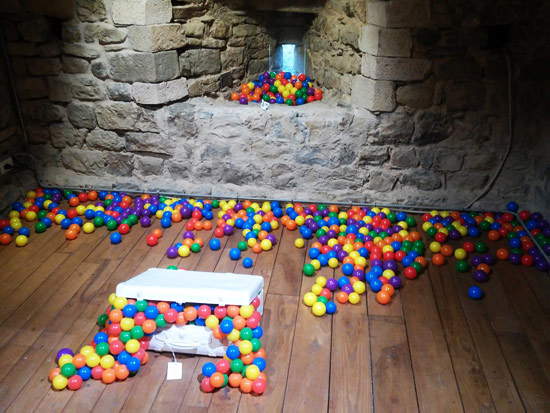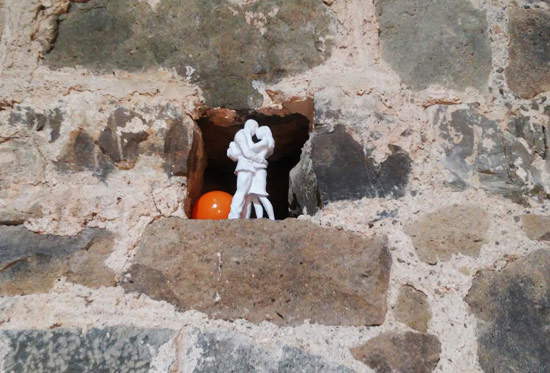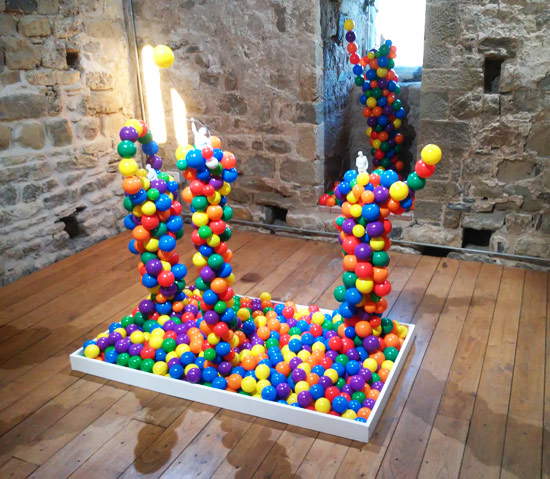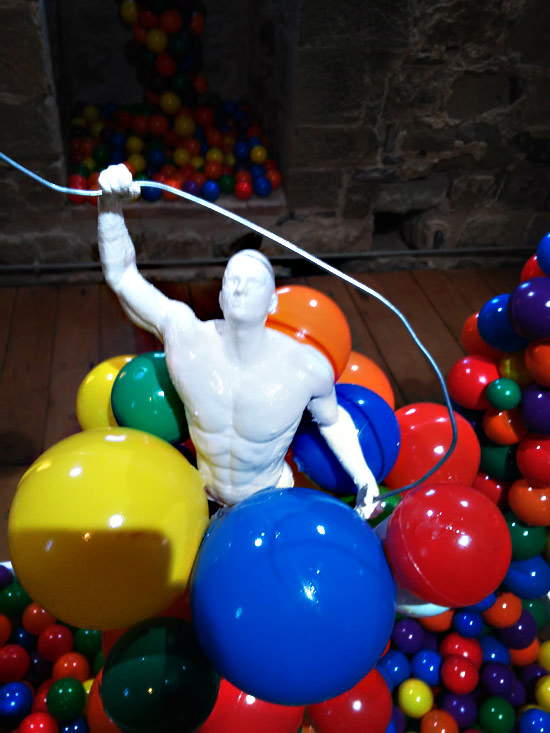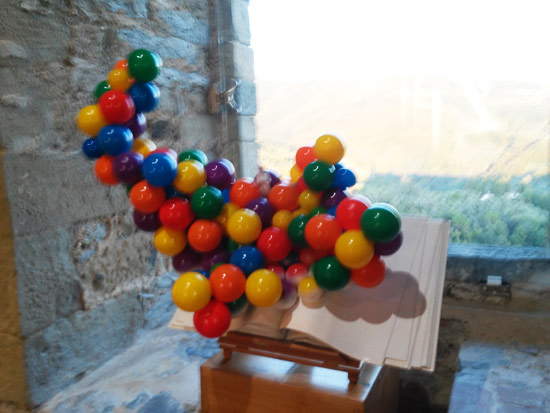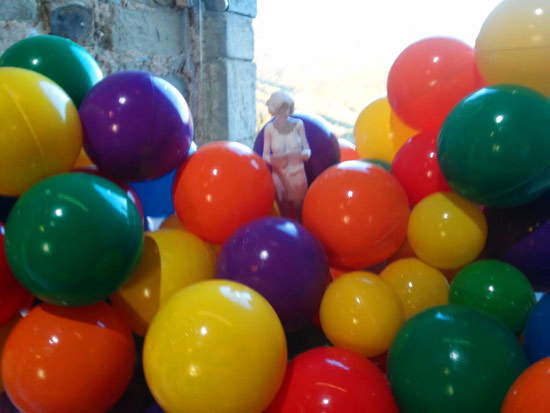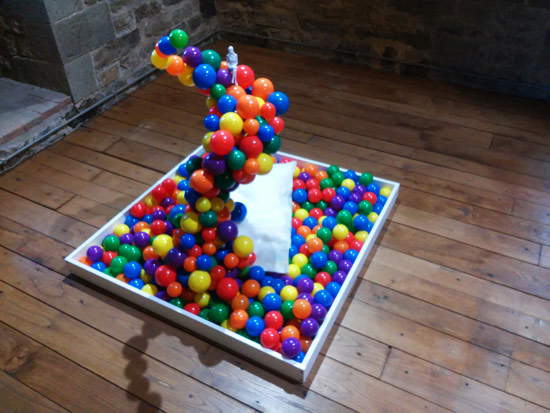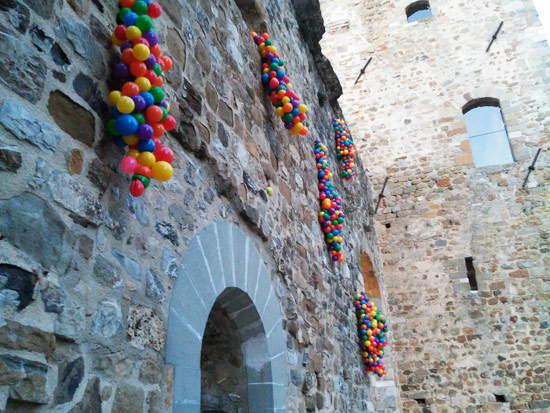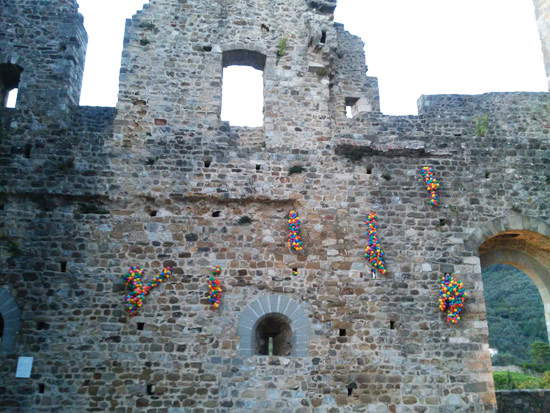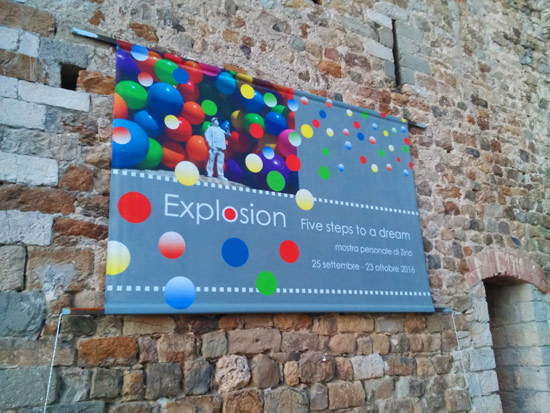by Federico Giannini (Instagram: @federicogiannini1), published on 28/09/2016
Categories: Works and artists
- Recensioni mostre / Disclaimer
'Five steps to a dream' is the latest artistic venture of Luigi Franchi aka Zino, an interesting contemporary artist who here develops the theme of dreams.
You cannot stem the sea, “you cannot stop the sea.” The phrase is stamped on a suitcase tag, the one that usually carries the number to call in case the owner loses it. But, this time, the loss is to be considered lucky, and even happier will be the eventuality if someone decides to open the suitcase: an unstoppable torrent of colored balls will come out of it, spreading like an overwhelming fluid into the environment. There is no container that can contain the sea, especially if it is a sea of dreams, of creativity, of imagination. The message is disarming in its simplicity, and at the same time it is powerful in the forms the artist has decided to give it. An ajar suitcase, in fact. From which emerge polyvinyl spheres colored inrainbow hues, flooding the room, under the watchful eye of a little man who, seated, watches pensively. The installation is called Exodus, and the artist is Zino, a nickname for Luigi Franchi (Teramo, 1973), an artist whose educational path unraveled through the University of Bologna and studies as a restorer between Florence, Rome and Bologna, has created a fertile humus from which fresh, exciting ideas sprout, striking and reaching the viewer directly.
 |
| Zino, Exodus (2016; PVC objects and spheres; Castelnuovo Magra, Tower of the Castle of the Bishops of Luni) |
 |
| Zino, Exodus, detail |
 |
| Zino, Exodus, detail |
Zino seeks to establish a dialogue that has no mediators other than the work itself. There is the creativity of the artist, there is the viewer, and there is the work of art, whose task it is to communicate the message. Only those who know a work well, how it comes into being, what is the process that leads it to its final form, can take such a strong stance towards those who admire it. And Zino, as a restorer who has gotten his hands on a large number of ancient works, as a connoisseur of art history and as a contemporary artist with acumen and sensitivity, succeeds well in this endeavor. The visitor to a museum or exhibition who finds himself in front of one of his works hardly passes by indifferently: Zino’s works capture him in a whirlwind of surprise, questioning glances first and amused later, thoughts, reflections, discussions. Some may accuse him of excessive simplicity, but behind this apparent manifestation, points out art critic Guya Bacciocchi, is concealed "a much more complicated soul, because the images are as we see them, but at the same time they are different, because even the simplest of objects can become a rebus in the eyes of another person."
Even this latent ambiguity reveals the depth of thought behind Zino’s works, because his art lends itself to a multi-layered reading, and it will be the observer’s sensitivity to determine whether the depth of his or her analysis will be enough to derive a meaning from the work, which in any case, contrary to what happens with many works of art for which a superficial reading is not sufficient to translate the image into a message, in Zino already emerges by virtue of an easy iconography that offers anyone tools to be able to decipher it. These are the characteristics that also distinguish Five steps to a dream, the Abruzzo artist’s latest endeavor: a work that combines sculpture, installation and performance, but also a site-specific intervention designed for the Tower of the Castello dei Vescovi di Luni in Castelnuovo Magra, a village inserted in one of the most sensitive areas of Italy to the problems ofcontemporary art. A work that, as is typical of Zino, is cloaked in a typically pop lightness, but at the same time lays its foundation on a cultural substratum that refers back to psychoanalysis, to the studies of Freud, whose theory on the interpretation of dreams is revisited by the artist in a collective, universal key, so that the dream still turns out to be the unconscious manifestation of a desire, but expands to invest analytical thought and creative thought that rework the dream visions to give them accessible meaning and forms. Five steps to a dream is simultaneously a game, a philosophical system, a journey into the mind of which five categories (desire, instinct, analytical thinking, creative thinking, unconscious) are examined, “a perfect metaphor for everything that surrounds luomo, everything that exists.”
The aforementioned Exodus is but the first stage of a journey that runs vertically through the Tower’s five floors: the first step in an installation whose individual pieces would already quietly shine by their own light, but whose luminosity is enhanced by an overall view. The leitmotif is the PVC spheres that refer to a playful dimension: they are the same ones in which children swim in the spaces reserved for such play. And for Zino, play is a “primary and fundamental need for contemporary man”: man, after all, is present in Five steps to a dream in the form of small sculptures obtained from 3D printing that interact with the spheres, as in the second “step” of the installation, Shoots, where we see four guns shooting colored bubbles and all around couples hugging and exchanging kisses, people reading, others walking. The task of making clear how much contemporary man “needs” play is entrusted to the third work, State of mind, where, on the highest of three pinnacles of colored spheres, a character with a sculptural physique clings to a yellow ball that rises like a balloon.
 |
| Zino, Shoots (2016; PVC objects and spheres; Castelnuovo Magra, Tower of the Castle of the Bishops of Luni) |
 |
| One of the 3D printed models around Shoots |
 |
| Zino, State of mind (2016; 3D printing and PVC spheres; Castelnuovo Magra, Tower of the Castle of the Bishops of Luni) |
 |
| Zino, State of mind, detail |
References to the liquid society theorized by Bauman, to that “liquidity of our time that makes everything elusive, elusive and formless,” also return, but while many contemporary sociologists and philosophers have interpreted this “liquidity” in a negative light, it is not necessarily the case that from a situation in which “every point of reference is missing” (to quote Umberto Eco’s “summary”), assuming that points of reference were there, and moreover that their presence was a good thing, an optimistic reading can be derived, because “elusive” can also mean “free from constraint” or, more generally, “free” in the narrow sense. And if point of reference par excellence of a supposed “solid society” can be identified in religion, even in Five steps to a dream the ironic vision of faith, almost a topos, a constant in Zino’s art, returns to manifest itself in Holy book, a book from whose pages colored balls fly upward: sacred were (and are for those who believe) the books on which a religious tradition is founded, but even more sacrosanct is our right to think about a book and to interpret the reading according to our feeling, as is being done by the girl whom Zino inserts at the center of the colorful whirlwind rising from the volume at the center of the fourth floor of the Tower. The conclusion of the journey is delegated to that dream that constitutes the main subject of Five steps to a dream (as well as of the fifth step, titled simply Dream): the spheres, this time, soar from a pillow resting on the ground. You cannot stem the sea, we return to the starting point: Zino gives visual concreteness to the concept of “dream,” which again begins to invade the room, because dreams cannot be contained, so much so that not even the Tower itself can hold them back, and they come out of windows and loopholes to pour into the suburb.
 |
| Zino, Holy Book (2016; object, resin and PVC spheres; Castelnuovo Magra, Tower of the Castle of the Bishops of Luni) |
 |
| Zino, Holy Book, detail |
 |
| Zino, Dream (2016; object, resin and PVC spheres; Castelnuovo Magra, Tower of the Castle of the Bishops of Luni) |
 |
| Zino’s Five steps to a dream installation on the facade of the Castle of the Bishops of Luni (Castelnuovo Magra) |
 |
| Five steps to a dream on the facade of the Castle of the Bishops of Luni |
 |
| Detail with the Tower |
Then, in the end, as happens to dreams and artistic performances, everything will fade away, and the only trace that will remain, will be etched in our memory. To touch upon Zino’s dream, however, there is still time: the exhibition that welcomes Five steps to a dream, curated by an Andrea Zanetti who has long dedicated himself to the work of the Abruzzese artist, contributing to increasing his fortunes (never more than now on a steep rise), is open until October 23, 2016 in the Tower of the Castello dei Vescovi in Luni. For those who will be reading these lines by that date, it is an invitation to spend an early autumn weekend in Castelnuovo Magra to discover how much revolutions owe to dreams, how it is possible to give shape to a strong idea, how contemporary art can establish with its users a genuine, friendly, fruitful relationship. For those who, on the other hand, will happen upon these pages later, when Five steps to a dream will probably be just the shadow of an image after an awakening, at best fixed on the pages of a catalog, the invitation to discover Zino, an artist who makes playful spontaneity, visual power, revisited pop aesthetics, and depth of thought the basic ingredients of his art, with a purpose, remains valid nonetheless: in Zanetti’s own words, not necessarily to make everyone “agree with the thinking Zino proposes,” but rather to put us in a position to “find our own.”
 |
| Zino, Five steps to a dream, through Oct. 23, 2016 in Castelnuovo Magra |
Warning: the translation into English of the original Italian article was created using automatic tools.
We undertake to review all articles, but we do not guarantee the total absence of inaccuracies in the translation due to the program. You can
find the original by clicking on the ITA button. If you find any mistake,please contact us.
